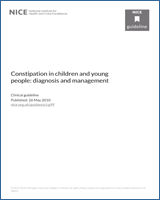From: Constipation in children and young people: diagnosis and management

Constipation in children and young people: diagnosis and management.
NICE Clinical Guidelines, No. 99.
London: National Institute for Health and Care Excellence (NICE); 2017 Jul.
Copyright © NICE 2019.
NCBI Bookshelf. A service of the National Library of Medicine, National Institutes of Health.